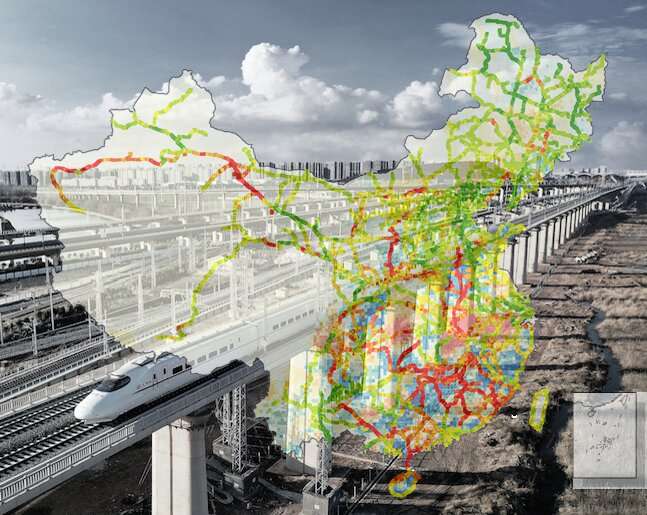Railway infrastructure susceptible to greater damages from climate change
Just half a degree Celsius less warming would save economic losses of Chinese railway infrastructure by approximately $0.63 billion per year, according to a new paper published by a collaborative research team based at Beijing Normal University and the Institute of Atmospheric Physics, Chinese Academy of Sciences, China.
The study, which appears in Transportation Research Part D recently, found that the rainfall-induced disaster risk of railway infrastructure has increased with increasing extreme rainfall days during the decades 1981-2016. Limiting global warming to the Paris Agreement target of 1.5 oC instead of 2.0 oC would significantly reduce the disaster susceptibility of Chinese railway infrastructure to extreme precipitation, according to Liu Kai, the first author of the paper.
Liu is an associated professor at the Academy of Disaster Reduction and Emergency Management, Beijing Normal University.
"Flood disaster can inundate the railway track, cause failures of the subgrade and track structure. Based on our statistics, a total of 975 historical railway rainfall-induced disasters was reported from 1981 to 2016. The rainfall-induced debris flow had the largest contribution, about 42%, followed by the rainfall-induced flood, which is about 26%, rainfall-induced landslide—about 18%—and rainfall-induced compound hazards, about 14%,"Liu said.
The team used a random forest (RF) machine-learning model to calculate the disaster susceptibility and quantify the relationship between susceptibility and precipitation change.
"We found a remarkable increase in the disaster susceptibility of railway lines along the Yangtze River valley, which is the economic center of China with the largest population density." Said LIU, "The disaster susceptibility has increased by 30% during the period 1999-2016 relative to that in 1981-1998 ."
Liu and her team, collaborated with Dr. Tianjun Zhou, professor of the Institute of Atmospheric Physics, Chinese Academy of Sciences, combined CMIP5, an archive of comprehensive climate models, with socio-economic projections to investigate future climate changes and the accompanying impacts. The researchers specifically examined extreme precipitation changes under RCP4.5 and RCP8.5 scenarios [RCP4.5 and 8.5 scenarios represent a possible range of radiative forcing values in the year 2100 relative to pre-industrial values (+4.5 and +8.5 W/m2, respectively)] over three time periods including near term (2020-2039), mid-term (2040-2059), and long term (2080-2099).
The scientists found that 32.0% and 45.0% of land area will be exposed to an increase in the annual average extreme rainfall days of more than 0.5 days by 2050 and 2090 under RCP8.5. The proportion of railway infrastructure with high disaster susceptibility is projected to increase from the baseline period level (1981-1998) of 1.1% to 4.5% by 2050 and up to 12% by 2090 under RCP8.5.
"We extended the projection to the changes in the proportions of railway lines at high risk for specific levels of 1.5 oC, 2 oC, and 3 oC global warming and measure the benefits of mitigation by calculating the avoided impact. The avoided impact, or railway exposure to high disaster susceptibility, would be 90% and 391% if warming was limited to 1.5oC compared to the impact for 2 oC and 3 oC warming under RCP8.5, respectively." said Prof. Zhou, the co-author of the study. Under RCP8.5, with a global average temperature increase of 1.5 oC, the direct damage and repair cost could increase to an annual amount of $1.47 billion. With 2o C warming, the damage doubles, and the loss grows to $2.10 billion.
"This study quantifies the influence of the climate change with its associated rainfall change on railway infrastructures in China. Chinese railway is still under large expansion. The mileage of China's railway lines will reach about 200,000 km in 2035 compared to about 140,000 km in 2020. The design of newly planned high-speed railway lines should incorporate climate change effects. How to reduce the disaster susceptibility of the world's most densely populated railway network should be planned to limit the adverse impact," Liu said.
- Matrix and Karlston
-

 2
2



Recommended Comments
There are no comments to display.
Join the conversation
You can post now and register later. If you have an account, sign in now to post with your account.
Note: Your post will require moderator approval before it will be visible.